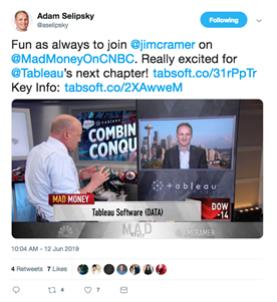But if the Seattle region is poised to become Salesforce “HQ2,” as itsco-CEO Marc Benioff proclaimed this week, then the place to be right now is the Tableau Software headquarters on the edge of the city’s Fremont neighborhood.
Tableau Software CEO Adam Selipsky sat down with GeekWire in his office overlooking the north shore of Lake Union on Tuesday afternoon, a day after Salesforce announced an agreement to acquire the Seattle-based data visualization company for $15.7 billion. It’s the biggest milestone yet in Tableau’s16-year journey from bedroom startup to4,200-person publicly traded company. And if the deal closes as planned next quarter, it will be the largest in Salesforce history.
Many of the integration details have yet to be worked out, and Selipsky declined to dish on the negotiations — even when we surprised him by figuring out the previously secret code name used by the companies during their talks.
But the former Amazon Web Services executive, who joined Tableau as CEO nearly three years ago, said he expects the combination of the companies to fuel the ongoing expansion of Tableau’s business and workforce.
“The intent is for the existing Salesforce business and the existing Tableau business, and therefore the joint overall business, to continue to grow rapidly,” Selipsky said. “And none of those businesses will be able to grow rapidly without continuing to grow our employee base rapidly. … I’m really excited for the growth. I think we’re all going to have a really fun ride.”
Continue reading for highlights from our conversation, edited for length and clarity.
Todd Bishop: What have the last two days and last few weeks been like for you?
Adam Selipsky: They’ve been tremendously exciting. I will confess, somewhat tiring, but mainly just filled with this excitement at seeing this combination really moving closer and closer towards actually happening. I think both companies felt such conviction about the strengths we can bring to customers and the opportunities we can bring to employees, and the impact we could have on our communities. We just kept getting more excited.
TB: What’s the biggest challenge you foresee in the integration of the companies?
Selipsky: I have no doubt there will be hard things. Any time you have to take something of this size and complexity … you know, Tableau is not a small company today. The good news is that I think everybody is going to really be eager and come at it with the right attitude. Salesforce has done about 60 of these, I believe, so I suspect they’ve learned a thing or two along the way about what works and what doesn’t work.
Something that I’m really excited about is just ensuring that all the employees on both sides are really excited about this and see the opportunity. I think it’s up to us to really make that clear. The initial reaction here has been really positive. It’s been really exciting to see. If we can continue to prove that that’s justified and that all these opportunities really exist, then we can make a better business for all of our customers. I think our employees will do amazing things.
TB: Tableau will continue to operate as an independent brand, with you as president and CEO, yet there’s also a discussion about ways to bring the products together. It seems like that, in and of itself, would be a difficult balance to strike, to remain independent at the same time you’re working with this other part of the company. How do you do that? Do you put people down there? Do they bring people up here? What does that look like?
Selipsky: Well, it’s still early, so I’m not sure we have all the answers. In fact, I’m sure we don’t have all the answers to that. There’s a lot of exciting possibilities about how to work together. We’ve talked about some of those, for example, on the product side. We don’t know the specifics of that. I don’t know what the product integration points are. I don’t know exactly which customers or which countries the sales collaboration is going to be most important. I’m really optimistic that everybody in both companies is really just going to come in with a learning attitude and a desire to figure out together, in a collaborative way, what’s going to work best.
At the end of the day, it’s all about making it work best for customers. As long as everybody remembers that our true north is making everything we do work for our customers, I suspect we’ll figure out good answers.
